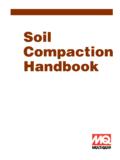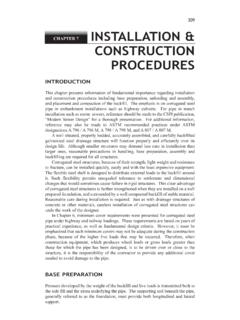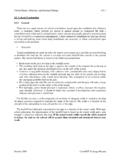Transcription of Soil Compaction Handbook - Multiquip Inc
1 SoilCompactionHandbookSOIL Compaction HANDBOOK3 What is soil ? soil is formed in place or deposited by various forces of nature such as glaciers, wind, lakes and rivers residually or organically. Following are important elements in soil Compaction : soil type soil moisture content Compaction effort required Why compact?There are five principle reasons to compact soil : Increases load-bearing capacity Prevents soil settlement and frost damage Provides stability Reduces water seepage, swelling and contraction Reduces settling of soilTypes of Compaction There are four types of Compaction effort on soil or asphalt: Vibration Impact Kneading Pressure soil CompactionSoil Compaction is defined as the method of mechanically increasing the density of soil .
2 In construction, this is a significant part of the building process. If performed improperly, settlement of the soil could occur and result in unnecessary maintenance costs or structure failure. Almost all types of building sites and construction projects utilize mechanical Compaction techniques. These different types of effort are found in the two principle types of Compaction force: static and force is simply the deadweight of the machine, applying downward force on the soil surface, compressing the soil particles. The only way to change the effective Compaction force is by adding or subtracting the weight of the machine.
3 Static Compaction is confined to upper soil layers and is limited to any appreciable depth. Kneading and pressure are two examples of static force uses a mechanism, usually engine-driven, to create a downward force in addition to the machine s static weight. The vibrating mechanism is usually a rotating eccentric weight or piston/spring combination (in rammers). The compactors deliver a rapid sequence of blows (impacts) to the surface, thereby affecting the top layers as well as deeper layers. Vibration moves through the material, setting particles in motion and moving them closer together for the highest density possible.
4 Based on the materials being compacted, a certain amount of force must be used to overcome the cohesive nature of particular soil (poor load support)Compacted soil (improved load support) soil densityFigure 1 soil Compaction HANDBOOK4 Figure 2 These illustrations show the results of improper Compaction and how proper Compaction can ensure a longer structural life, eliminating future foundation problems. soil Types and ConditionsEvery soil type behaves differently with respect to maximum density and optimum moisture. Therefore, each soil type has its own unique requirements and controls both in the field and for testing purposes.
5 soil types are commonly classified by grain size, determined by passing the soil through a series of sieves to screen or separate the different grain sizes. [See Figure 3] soil classification is categorized into 15 groups, a system set up by AASHTO (American Association of State Highway and Transportation Officials). Soils found in nature are almost always a combination of soil types. A well-graded soil consists of a wide range of particle sizes with the smaller particles filling voids between larger particles. The result is a dense structure that lends itself well to Compaction . A soil s makeup determines the best Compaction method to use.
6 There are three basic soil groups: Cohesive Granular Organic (this soil is not suitable for Compaction and will not be discussed here)results of poor compactionSOIL Compaction HANDBOOK5 Cohesive soilsCohesive soils have the smallest particles. Clay has a particle size range of .00004" to .002". Silt ranges from .0002" to .003". Clay is used in embankment fills and retaining pond soils are dense and tightly bound together by molecular attraction. They are plastic when wet and can be molded, but become very hard when dry. Proper water content, evenly distributed, is critical for proper Compaction . Cohesive soils usually require a force such as impact or pressure.
7 Silt has a noticeably lower cohesion than clay. However, silt is still heavily reliant on water content. [See Figure 4] Granular soilsGranular soils range in particle size from .003" to .08" (sand) and .08" to " (fine to medium gravel). Granular soils are known for their water-draining properties. CharacteristicsSand and gravel obtain maximum density in either a fully dry or saturated state. Testing curves are relatively flat so density can be obtained regardless of water content. The tables on the following pages give a basic indication of soils used in particular construction applications. [See Figures 5, 6 & 7]Figure 3sieve testWhat to look forGranular soils, fine sands and soils, mixes and movementWhen water and soil are shaken in palm of hand, they mix.
8 When shaking is stopped, they water and soil are shaken in palm of hand, they will not mix. When little or no and sticky. Can be or no cohesive strength when dry. soil sample will crumble high strength when dry. Crumbles with difficulty. Slow saturation in water. Figure 4guide to soil typesAppearance/feelCoarse grains can be seen. Feels gritty when rubbed between cannot be seen by naked eye. Feels smooth and greasy when rubbed between Compaction HANDBOOK6-- -- 1 1 -- -- 1 1 1 3-- -- 2 2 -- -- 3 3 3 --2 4 -- 4 4 1 4 4 9 51 1 -- 3 1 2 6 5 5 1-- -- 3* 6 -- -- 2 2 2 4-- -- 4* 7* -- -- 5 6 4 --4 5 -- 8* 5** 3 7 6 10 63 2 -- 5 2 4 8 7 6 26 6 -- -- 6** 6 9 10 11 --5 3 -- 9 3 5 10 9 7 78 8 -- -- 7** 7 11 11 12 --9 9 -- -- -- 8 12 12 13 --7 7 -- 10 8** 9 13 13 8 --10 10 -- -- -- 10 14 14 14 --GW Well-graded gravels, gravel/ sand mixtures, little or no fines GP Poorly-graded gravels, gravel/sand mixtures, little or no finesGM Silty gravels.
9 Poorly-graded gravel/sand/silt mixturesGC Clay-like gravels, poorly graded gravel/sand/clay mixturesSW Well-graded sands, gravelly sands, little or no finesSP Poorly-graded sands, gravelly sands, little or no finesSM Silty sands, poorly-graded sand/ silt mixturesSC Clay-like sands, poorly-graded sand/clay mixturesML Inorganic silts and very fine sands, rock flour, silty or clay-like fine sands with slight plasticityCL Inorganic clays of low to medium plasticity, gravelly clays, sandy clays, silty clays, lean claysOL Organic silts and organic silt-clays of low plasticityMN Organic silts, micaceous or diatomaceous fine sandy or silty soils, elastic siltsCH Inorganic clays of high plasticity, fat claysOH Organic clays of medium high plasticityGroup SymbolSoil TypeHomogeneous EmbankmentCoreShellErosion Resis-tanceCompactedEarth LiningSeepageImportantSeepage Not ImportantFrost Heave Not PossibleFillsFrost Heave PossibleSurfacing(NAVFAC , MAy 1982) * if gravelly ** erosion critical ** volume change critical -- not appropriate for this type of useFigure 5 SANDSLEANFATCLAYS & SILTSGRAVELSR olled Earth Fill DamsCanal SectionsFoundationsRoadwaysRelative Desirability for Various Uses(1=best.)
10 14=least desirable)relative desirability of soils as compacted fillSOIL Compaction HANDBOOK7 Effect of moistureThe response of soil to moisture is very important, as the soil must carry the load year-round. Rain, for example, may transform soil into a plastic state or even into a liquid. In this state, soil has very little or no load-bearing vs soil densityMoisture content of the soil is vital to proper Compaction . Moisture acts as a lubricant within soil , sliding the particles together. Too little moisture means inadequate Compaction Figure 6 IMPACTPRESSuREwith kneadingVIBRATIONKNEAdINGwith pressureVibrating SheepsfootRammerStatic SheepsfootGrid RollerScraperVibrating Plate CompactorVibrating RollerVibrating SheepsfootScraperRubber-tired RollerLoaderGrid Roller GRAVEL 12+ Poor No Good Very Good SAND 10+/- Poor No Excellent Good SILT 6+/- Good Good Poor Excellent CLAY 6+/- Excellent Very Good No Good Lift ThicknessPermeabilityFoundation SupportPavementSubgradeExpansiveCompacti onDifficulty GRAVEL Very High Excellent Excellent No Very Easy SAND Medium Good Good No Easy SILT Medium Low
















